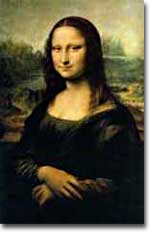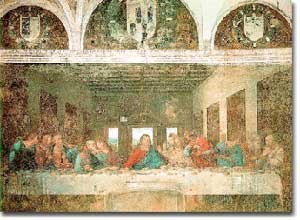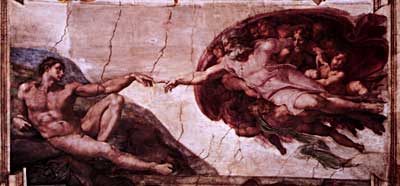| HOME |
The High Renaissance
The High Renaissance produced some of the most recognizable art of the western world. By the 16th century, the Renaissance had reached full blossom in the works of its greatest masters: Leonardo da Vinci (1452-1519) and Michelangelo Buonarotti (1475-1564). These two men left a legacy of pure genius that would bring the Renaissance in Italy to its culmination. Leonardo da Vinci's Mona Lisa, a portrait of a mysterious woman, is arguably the world's most recognizable painting. This painting exemplifies Leonardo's subtle use of light and shadow to create an exquisite softness and realism in human flesh. Critics have long marveled at the psychological complexity of Mona Lisa's personality and her mysterious expression — is she smiling? Leonardo da Vinci was the ultimate Renaissance man, for he was much more than just an artist. Leonardo possessed an interest and talents in virtually every human endeavor. His areas of study ranged from nature to music to math to anatomy to engineering to botany to the arts. Leonardo studied everything and kept notebooks carefully filled with his ideas, sketches, and diagrams. He was an inventor, designing new military defenses and plans for a flying machine and submarine. He conducted scientific experiments, dissected human corpses, and tried various painting techniques.
Of Michelangelo's works, none epitomizes the High Renaissance more than his statue David. Carved out of an old, unwanted block of marble, David stands an impressive 14 feet in height. Like Donatello's David before him, Michelangelo's David was a free standing nude sculpture. However, Michelangelo's David was a muscular, fully mature man, not the soft adolescent of Donatello's David. Michelangelo's David was confident, assertive, and determined. The new David was the perfect human specimen, seeming almost divine. In 1508, Pope Julius II called Michelangelo to Rome to begin a special project. Like the Medici family of Florence, the Popes of Rome were tremendous patrons of the arts. In this case, Julius II commissioned Michelangelo to paint the ceiling of the Sistine Chapel. The project would end up taking four years to complete and became a test of Michelangelo's artistic abilities and stamina. Lying on his back on top of scaffolding, Michelangelo painted with his head craned, paint and plaster dripping on his face and into his eyes.
While Leonardo and Michelangelo were the High Renaissance's most famous artists, others contributed in significant ways as well. Some of these artists include: Raphael Santi, Titian, Tintoretto, and Paolo Veronese. |
||||||
| MAIN | |||||||
| WEBQUEST CENTRAL | |||||||
|


